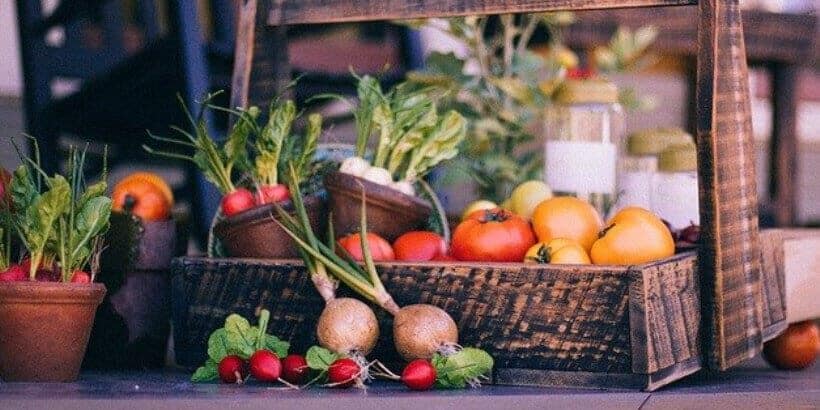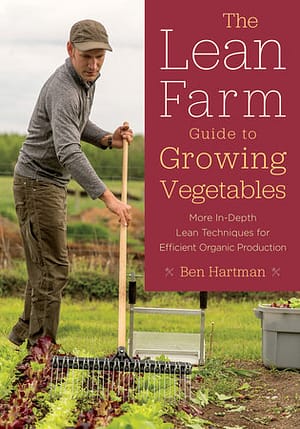The Lean Farm Guide: CSA Boxes

CSA boxes are becoming popular as the idea of buying local continues to become more appealing. As a farmer, offering a CSA box to your community is a great way to ensure that you have a market! Author Ben Hartman talks about this concept, and the overall idea of lean farming to reduce waste, in his webinar, 5 Concepts for Lean Farming. Below are some of his ideas about CSA boxes and how he makes them work for his community.
The following is an excerpt from The Lean Farm Guide to Growing Vegetables by Ben Hartman. It has been adapted for the web.
With a CSA, customers pay up-front for an agreed-upon amount of food delivered once per week. I know of no better way to pre-sell food: each sign-up equals one giant order.
The roots of the CSA model can be traced, in part, to black history. Professor Booker T. Whatley, of Tuskegee University in Alabama, was considered a twentieth-century pioneer in sustainable agriculture. In the 1970s he even toured the country promoting “smaller and smarter” farming through what he called “Clientele Membership Clubs.” The model involved households—“city folks, mostly”—paying in advance to receive food directly from a farmer. He said, “This enables the farmer to plan production, anticipate demand, and of course, have a guaranteed market.” His goal was to regenerate an agrarian black middle class.1 A version of the CSA model, called Teikei, was also used by Japanese farmers in the 1960s specifically to combat waste stemming from overproduction. We solicit CSA customers through email, Facebook, and flyers. Customers sign up through our web- site, where they pay and choose their box size and pickup locations.

Image from The Lean Farm Guide to Growing Vegetables
According to many farmers I have talked with and to recent data, the CSA model in many places is under duress. One survey conducted by Small Farm Central found that the average CSA farm in 2015 lost most of their customers by 2016: the customer retention rate was just 46.1 percent.2 One reason many current CSA farms struggle to keep customers, I suppose, is that the novelty has worn off. Whenever a new service arrives, customers are willing to put up with inconveniences to try it out. In the early days of CSAs, customers sometimes drove long distances, often at inconvenient times, to participate in the novel system. With CSAs now common, enthusiasm has waned. Also, mid-level grocers now carry organic food, as do many big-box stores, offering organic celery, Band-Aids, and blue jeans in one stop. CSA farms are no longer a unique option for buyers of natural food.
All of this puts pressure us to step up service. Several years ago we added refrigeration units to our pickup locations, allowing customers to pick up whenever it suited them rather than during a short window of time. More recently we have partnered with our local food co-op, where many of our customers shop, to serve as a pickup location. Customers pick up their CSA produce when they do their other shopping, saving a trip.
We also run CSA “tabs” at our farmers’ market booth.
Customers pay us up-front, as with a standard CSA, but instead of picking up a box every week, they come to our booth anytime it’s open and choose whatever items they want. We keep track of their balance in a notebook. If they pick up just one tomato or a mix of 10 items—or if they skip for an entire month—that is their prerogative. We give them a discount for paying up-front, and if they want large quantities—say a bushel of tomatoes—we ask for a bit of advance warning.
With all this flexibility, how do we decide what to grow? While we can’t plan with complete precision, we can use surveys to learn to as much as possible what CSA customers want. Twice each year I email a list of questions:
- Have we offered the right mix of foods for you?
- What else might make it easier for you to receive your food?
- Has the amount been too much, too little, or just right for you or your family?
The questions address what, when, and the right amount. We will never manage to please everyone, of course, but the answers we receive give insights useful for planning. The key in surveying customers is to keep it simple. Long-form questionnaires don’t get answered.
Check out some video excerpts about CSA boxes, what they contain, and how to construct them from Ben Hartman’s webinar about lean farming.
- Natasha Bowens, “CSA Is Rooted in Black History,” Mother Earth News, February 13, 2015, http://www.motherearthnews.com/organic -gardening/csas-rooted-in-black-history-zbcz1502.
- Simon Huntley, “CSA: We Have a Problem,” Small Farm Central, August 17, 2016, http://www.smallfarmcentral.com/Blog-Item-CSA -We-have-a-Problem.
Recommended Reads
Recent Articles
Aside from the sheer pleasure of telling your friends, straight-faced, that you maintain your garden using something called a “chicken tractor,” there are a slew of other benefits to working the land with a few of your animal friends. Getting rid of pests without chemicals, for one; letting them do the work of weeding and…
Read MoreIf the idea of running a vegetable farm sounds daunting, you’re not alone. What can you do to simplify techniques and reduce expenses? Where do you even begin?
Read MoreWhen you’re walking around the grocery store looking at the vegetables, it’s probably hard to imagine that a century ago there was twice the amount of options.
Read MoreIf you love tomatoes, you probably already know just how many varieties of these summertime staples there are. But do you know what makes each one unique?
Read MoreAdding the long game of trees to your system results in a deeper and more reliable, resilient and profound presence to your annual vegetable production.
Read More








